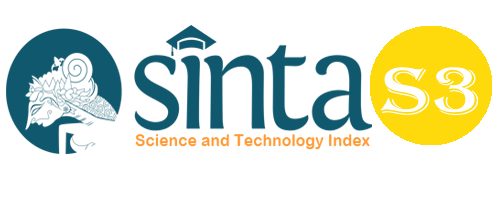EFL Teachers Cognition and Practices of Higher Order Thinking Skill in the Indonesian Context
Abstract
Since teacher’s cognition of Higher Order Thinking Skills (HOTS) is one of the factors which determines the students’ HOTS, teachers’ cognitions may predispose in English language teaching practices. Teacher’s cognition has been a determining variable in a triumph of teaching practice for it holds essential roles in shaping the students’ cognition and skills. Moreover, HOTS teaching can assist the students to respond to the 21-st century challenges that require the students to think critically, being creative and innovative, communicate well, being collaborative, and confident. Teachers’ cognition and practices of higher order thinking skills in English language teaching explored in this research. Two EFL teachers from vocational high schools in West Java participated in classroom observations and a semi-structured interview. Meanwhile, document analysis also employed to triangulate the data. This research employed descriptive qualitative since it aimed to investigate the teachers’ cognition and practices of higher order thinking skills that needed qualitative insights. This study revealed that the EFL teachers’ knowledge derived from Bloom’s taxonomy revised theoretical framework. They shared the same belief in teaching HOTS in English to students. And they had positive thought toward HOTS. They practiced different methods in teaching HOTS in the classroom based on their cognition, even though there was still found incongruency between their cognition of HOTS and teaching practices due to contextual factors.
Keywords
Full Text:
PDFReferences
Anderson, L. W. & Krathwohl, D. (2001). A taxonomy for learning, teaching and assessing a revision of Bloom’s educational objectives. Longman.
Ansori, M. (2019). Teacher’s beliefs and practices in the integration of higher order thinking skills in teaching reading. ELS Journal on Interdisciplinary Studies on Humanities, 2(4), 541-555.
Australian Council for Educational Research. (2015). Developing higher order thinking skills. ACER.
Barnard, R., & Burns, A. (Eds.). (2012). Researching language teacher cognition and practice: International case studies. Multilingual Matters.
Borg, S. (2003). Teacher cognition in language teaching: A review of research on what language teachers think, know, believe, and do. Language Teaching, 36 (02), 81-109.
Clark, C. M., & Peterson, P. L. (1986). Teachers’ thought processes. In M. C. Wittrock (Ed.). Handbook of Research on Teaching (3rd ed.). Macmillan.
Collins, R. (2014). Skills for the 21st Century: teaching higher-order thinking. Curriculum and Leadership Journal, 12(14), 1-8.
Conklin, W. (2012). Higher order thinking skills to develop 21st century learners. Shell Education Publishing, Inc.
Crusan, D., Plakans, L., Gebril, A. (2016). Writing assessment literacy: Surveying second language teachers’ knowledge, beliefs, and practices. Assessing Writing, 28 (2016), 43-56.
Directorate General of Teachers and Education Personnel. (2019). Buku Pegangan Pembelajaran Berorientasi pada Keterampilan Berpikir Tingkat Tinggi. Ministry of Education and Culture: Jakarta.
Golombek, P. R. (2015). Redrawing the Boundaries of Language Teacher Cognition: Language Teacher Educators’ Emotion, Cognition, and Activity. Modern Language Journal, 99(3), 470–484. https://doi.org/10.1111/modl.12236
Hashim, H., Ali, M. N., Shamsudin, M. A. (2017). Infusing high order thinking skills (HOTS) through thinking-based learning (TBL) during ECA to enhance students’ interest in STEM. International Journal of Academic Research in Business and Social Sciences, 7(11), 1191-1199.
Hopson, M. H., Simms, R. L., Knezek, G. A. (2001). Using a Technology-Enriched Environment to improve Higher-Order Thinking Skills. Journal of Research on Technology in Education, 34(2), 109-119.
Johnson, K. (2001). An introduction to language learning and teaching. Pearson Education.
Kim, S., Raza, M., Seidman, E. (2019). Improving 21st-century teaching skills: The key to effective 21st-century learners. Research in Comparative & International Education, 14(1), 99-117.
Lewis, A., & Smith, D. (1993). Defining higher order thinking. Theory into Practice, 32(3), 131–137.
Manichander, T. (2016). Teacher and teaching process. Laxmi Book Publication.
Nespor, J. (1987). The role of beliefs in the practice of teaching. Journal of Curriculum Studies, 19(4), 317–328.
Philips, S. (2020). Education and Curriculum Reform: The Impact They Have On Learning. Budapest International Research and Critics in Linguistics and Education (BirLE) Journal. P. 1074-1082.
Pretorius, L., Mourik, G. P.V., Barrat, C. (2017). Student choice and higher-order thinking: Using a novel flexible assessment regime combined with critical thinking activities to encourage the development of higher order thinking. International Journal of Teaching and Learning in Higher Education, 29 (2), 389-401.
Priyono, E., Fahrizal, Priyono, Basri. (2017). The Application of Problem-Based Learning Strategy to Increase High Order Thinking Skills of Senior Vocational School Students. International Education Studies, 10(6). 123-129.
Raiyn, J. (2016). The Role of Visual Learning in Improving Students’ High-Order Thinking Skills. Journal of Education and Practice, 7(24), 115 – 121.
Resnick, L. (1987). Education and learning to think. National Academy Press.
Retnawati, H. Djidu, H., Kartianom., Apino, E., Anafiza, R. D. (2018). Teachers’ knowledge about higher-order thinking skills and its learning strategy. Problems of education in the 21st century,76 (2), 215-230.
Schulz, H., & FitzPatrick, B. (2016). Teachers’ understandings of critical and higher order thinking and what this means for their teaching and assessments. Alberta Journal of Educational Research, (62) 1, 61-86.
Setyarini, S., Muslim, A. B., Rukmini, D., Yuliasri, I., Mujianto, Y. (2018). Thinking critically while storytelling: Improving children’s HOTS and English oral competence. Indonesian Journal of Applied Linguistics, (8)1, 189-197.
Shah, M. et al. (2020). The Development Impact of PT. Medco E & P Malaka on Economic Aspects in East Aceh Regency. Budapest International Research and Critics Institute-Journal (BIRCI-Journal). P. 276-286.
Shi, L., Baker, A., Chen, H. (2019). Chinese EFL teachers’ cognition about the effectiveness of genre pedagogy: A case study. RELC Journal, (50) 2, 314- 332.
Sopiani, P.S., Said, I., Ratnawati. (2019). Investigating Students’ Higher Order Thinking Skills (HOTS) in Writing Skill (A Case Study at the Eleventh Grade of a Senior High School in Banjar). Journal of English Education and Teaching. 3(3). 328-342.
Tan, O. S. (2004). Enhancing thinking through problem-based learning approaches. Cengange Learning.
Tsui, A. B. M. (2011). Teacher education and teacher development. In E. Hinkel (Ed.), Handbook of research in second language teaching and learning (Vol. 2). Routledge.
Wang, S., & Seepho, S. (2017). Facilitating Chinese EFL learners’ critical thinking skills: The contributions of teaching strategies. SAGE Open, 7(3), 1-9.
Widiawati, L., Joyoatmojo, S., Sudiyanto. (2018). Higher Order Thinking Skills as effect of problem-based learning in the 21st century learning. International Journal of Multicultural and Multireligious Understanding. 5(3). 96-105.
Wiliams, D. (2017). Assessment and learning: some reflections. Assessment in Education: Principles, Policy & Practice, 24(1), 394-403.
Yunus, M.M., Salehi, H., Amini, M. (2016). EFL Teachers’ Cognition of Teaching English Pronunciation Techniques: A Mixed-Method Approach. English Language Teaching. 9 (2), 20-42.
Zohar, A., & Schwartzer, N. (2005). Assessing teachers’ pedagogical knowledge in the context of teaching higher‐order thinking. International Journal of Science Education, 27(13), 1595-162.
DOI: https://doi.org/10.33258/birci.v5i1.3731
Article Metrics
Abstract view : 161 timesPDF - 67 times
Refbacks
- There are currently no refbacks.

This work is licensed under a Creative Commons Attribution-ShareAlike 4.0 International License.

This work is licensed under a Creative Commons Attribution-ShareAlike 4.0 International License.

_.gif)

















_.gif)



